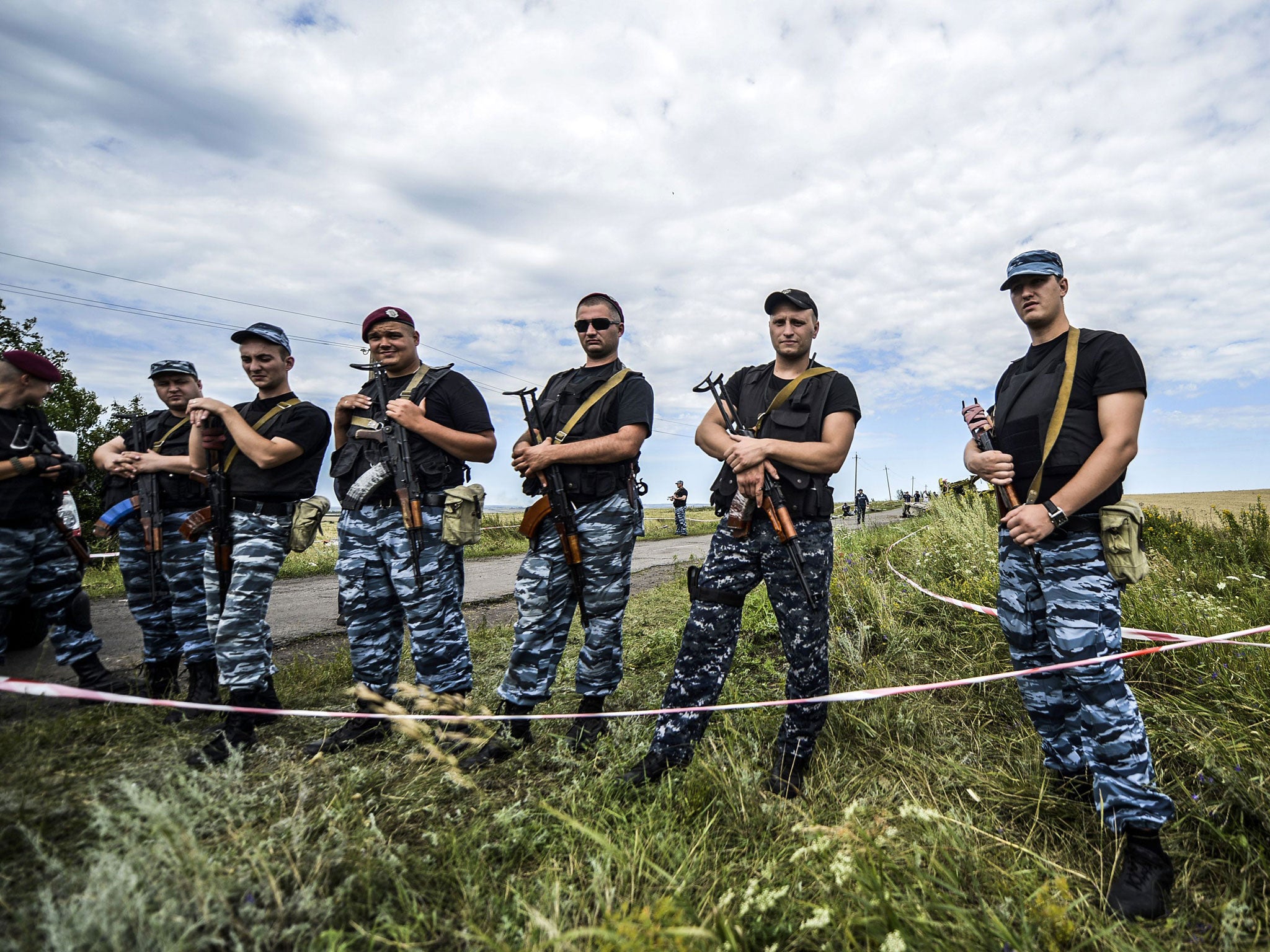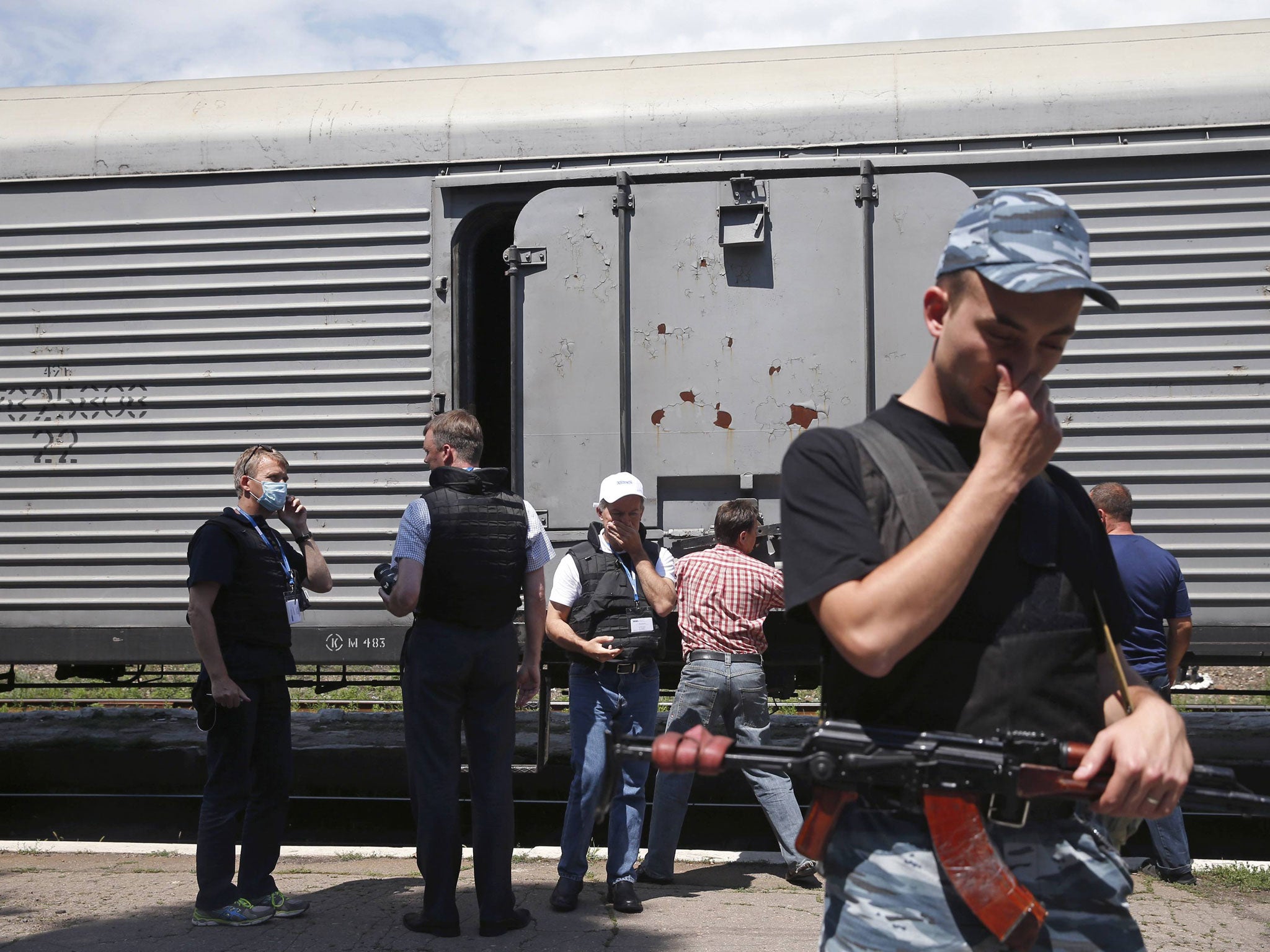Malaysia Airlines MH17 crash: As the body bags arrive, confusion reigns on the hillside disaster site
Villagers in Grabove, eastern Ukraine, tell Andrew Buncombe of the moment Flight MH17 fell out of the sky and the chaos that followed

It was the grimmest of tasks and one for which they were equipped with nothing more than stretchers, body bags and green rubber gloves.
When the rescue workers found a body, or at least a body largely intact, they placed it into a black nylon bag, drew shut the zipper and laid it on the edge of the crash site.
Yet much of their work involved collecting individual pieces of flesh, fragments of remains. These they scooped up with both hands and placed into plastic carrier-bags which they then tied tightly shut.
By late morning, the workers, many of them young men, had laid out five body bags and a number of smaller sacks of fragments. Did the bodies belong to men or women? “I don’t know,” said the man supervising the task, drawing on a succession of cigarettes as he watched the work. “Only the experts can tell.”
Three days after Malaysia Airlines Flight 17 was shot down en route to Kuala Lumpur from Amsterdam with the loss of 298 people, emergency workers under the supervision of armed pro-Russian rebels in eastern Ukraine were still working to recover the bodies from this quiet hillside outside Donetsk.
Officials said the bodies of up to 200 passengers and crew had been gathered and taken to refrigerated railway wagons at a station, waiting to be repatriated home, at some point, to their families in the Netherlands, Malaysia, Britain and elsewhere.
But amid ongoing accusations and counter-accusations between the Ukrainian government and rebel forces, questions remained about the ability of the rescue workers to complete the task and the manner in which it’s been done.
The villagers of Grabove, a community of farmers and coalminers, had been going about their business last Thursday afternoon when they heard a huge noise in the sky and looked up to see parts of the Boeing 777 falling to the earth. The emergency workers said there were a total of eight major sites, located across a six-mile stretch of fields, where bodies and debris were located. Here, in Grabove, close to the Russian border and with a large part of the hillside turned to cinder, at least one of the jet’s engines hit the ground.
The engine, along with other large parts of debris, was inside an area that had been taped off by the recovery workers, technically in the employment of the Ukrainian government. When the wind picked up, flapping the red and white tape, the air smelled of bodies and burning.
Najejda Ivanava, who said she had spent her entire life in Grabove, had been sitting outside, chatting with friends when she saw the plane “rolling all around the village”. Yesterday morning, the 71-year-old Mrs Ivanava, with four gold teeth and wearing house slippers, stood watching the recovery operation.
“[The plane] moved right, it moved left,” she said. “There were sparks flying out from it... We dived on to the floor.”
She said most of them had been too afraid to go to the site. Instead, one of the neighbours got on his bicycle to see what had happened. He returned with stories of scores of dead bodies, many of them still strapped in their seats. This had made her feel even less like going to the scene.
“My neighbour turned on the TV and we heard that the [rebels] had then arrived,” she added. “We feel so sad that so many people died.”
As she watched, standing outside an asbestos-roofed cottage where a number of apricot trees now bore scorched fruit, a delegation from the Office for Security and Cooperation in Europe (OSCE) arrived. They were escorted by a dozen or so armed men, several of them wearing masks that covered their faces. With the government of Ukraine unable to oversee the emergency operation, the OSCE delegation has become the only international body granted access to the sites.
Last night, it was reported that the Dutch authorities were negotiating to have the train carriages placed in the control of the Ukrainian government. The Dutch Prime Minister, Mark Rutte, said a team from the Netherlands would likely arrive today to begin the process of identification.

Amid repeated claims from Ukraine, the US and Britain that evidence points to the plane being shot down by the pro-Russian rebels, the rebels have in turn claimed that the Ukrainian armed forces were responsible for the tragedy. Some have even said that the Ukrainian armed forces had shot down the plane in the belief that it was the aircraft of the Russian leader, Vladimir Putin.
The people of Grabove, the witnesses to such extraordinary scenes, appeared uncertain what to believe. One man, riding a bicycle, said the villagers either worked in the coal mines that dotted the landscape or else grew vegetables.
He said he had seen fire in the sky and saw pieces of debris falling to the ground. Asked what he believed had befallen the plane, he said: “What the Ukrainian channels are saying is not true.” He refused to say anything else and pedalled off.
What the villagers cannot escape is the steady realisation that this sloping hillside has become not just an emergency site but most likely a crime scene and a de facto burial area. Who knows how many bodies will eventually be recovered from here, and how many will not.
Meanwhile, the young men with their body bags and green plastic gloves, continued their work. By early afternoon, the line of body bags had expanded to 19. The grimmest of tasks goes on.
Join our commenting forum
Join thought-provoking conversations, follow other Independent readers and see their replies
Comments